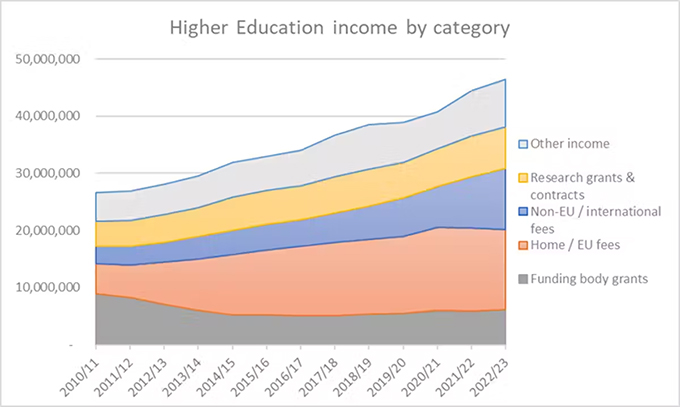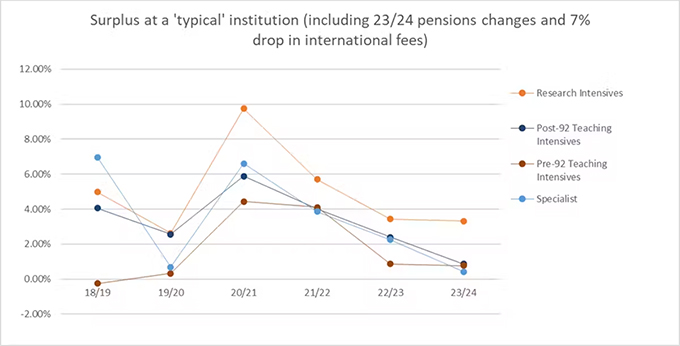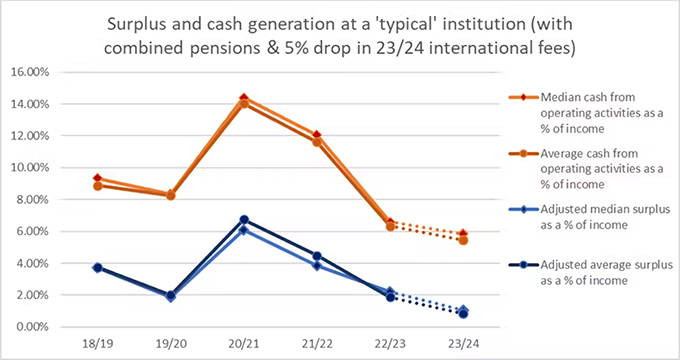
The higher education sector in the UK is in financial crisis. Over 60 institutions have announced severance or redundancy programmes, and around 40% expect to be in deficit in 2023-24.
The financial collapse of one or more universities is now a distinct possibility, with disruptive economic and social repercussions for the regions in which they are based.
This alarming situation is the result of a long-term experiment in market-based educational provision in UK universities. Simply put, universities are expected to compete against one another for students, research grants and other income sources.
Marketisation began with the introduction of student loans in 1990, tuition fees in 1998 and increases to those fees in 2004. In 2012, tuition fees trebled in England and Wales to a fixed cap of £9,000 per year (now £9,250), while government grants were cut. In 2015 the government removed the student number caps, further accelerating market competition.
All of this has led to a university business model that works on the principle of volume – the more students the better. It also relies on cross-subsidisation: using money from international student fees, for instance, to fund courses that enrol a high proportion of home students.
Attracting students in a competitive environment meant that universities had to borrow heavily to invest in new facilities. These include both teaching buildings and student accommodation.
The tripling of tuition fees and the rise in student numbers meant that the decade from 2012 to 2022 was a boom period for UK higher education. Even the COVID pandemic had limited effect on university finances. This was because the freezing of staff pay in 2020-21 helped control costs, while growth in home student recruitment partially offset a temporary drop in international students felt as a result of the pandemic.
University overheads fell during lockdowns, but students were billed for university accommodation and courses that many did not attend in person. In 2021-22, international numbers recovered, creating a one-off windfall. Meanwhile, protracted staff industrial action saved salary costs at the expense of the student experience.
The bubble bursts
However, the financial picture for higher education finance is now far from positive. The cap on fees at £9,250 from 2018, with no increase linked to inflation, means that universities now make a £2,500 (real terms) loss on every home student.
This drop in income was not made up for through any increases to grants received from the government. The situation was exacerbated as inflation spiked and interest rates rose on the mountain of debt the sector had built up.
Overseas students, meanwhile, pay considerably higher fees. This has led to the proportion of an average university’s income sourced from international student fees spiking, from 15.2% in 2016-17 to 24.6% in 2022-23.

Higher Education income by category. Dr James Brackley, Professor Adam Leaver and Dr David Yates; data from HESA, Author provided (no reuse)
This increasing reliance on cross-subsidisation due to underfunding home students places and rising international fees was always going to bite when the international student market inevitably tightened.
Meanwhile, staff costs are being controlled by an increasing reliance on teaching staff on insecure, temporary contracts.
Academics and support staff have experienced severe workload increases. During the pandemic, universities cut staff numbers and student services at the worst possible time, further damaging working conditions.
The “pile ‘em high” approach – cutting staff while recruiting ever greater student numbers – has had a predictable effect on quality and student experience relative to international competitors.
Measuring risk
To understand the seriousness of this situation, we have developed a risk-scoring tool based on data available from the Higher Education Statistics Agency (Hesa). This shows which kinds of universities are at particular financial risk. While all universities are seeing a significant drop in their surplus, the prestigious, research-intensive Russell Group universities are significantly better off than newer universities that focus on teaching.

Standardised risk scores by provider sub-type. Dr James Brackley, Professor Adam Leaver and Dr David Yates; data from Hesa, Author provided (no reuse)
This situation looks even more extreme when we also look at cash generation at an average university. This is now considerably worse than at any point in the past five years.

Surpluses and cash generation (modelling pension changes only) Dr James Brackley, Professor Adam Leaver and Dr David Yates; data from Hesa, Author provided (no reuse)
Without a change of direction, universities are likely to continue to make short-term, reactive decisions that will undermine the longer-term value and values of the sector.
Cutting research time, undermining working conditions and increasing workloads with a view to expanding generic, easy-to-deliver courses with poor student-staff ratios does little to prepare UK students for life beyond academia. It does little to allow unique specialist programmes to thrive, and it certainly does not enhance the wider pursuit of knowledge.
Many of the proposals currently being put forward appear to be little more than sticking plasters. The new Labour government intends to make it easier for international students to study in the UK. This is welcome in the short term, but only exposes the sector to similar shocks in the future if it deepens the reliance on (or exploitation of) international students to prop up university finances.
Alternatively, raising home student fees would reduce the reliance on overseas recruitment, but does little to address the cost of living crisis faced by students and may remove opportunities for student who fear the prospect of ever increasing graduate debt.
Higher education funding reform requires a more radical rethink and an approach that values the university sector as a whole. This funding reform needs to focus on the public values we want universities to pursue, recognising that the radical shift to a market-based system in recent decades is beginning to undermine the long-term viability of the sector.
Author Bios: James Brackley is a Lecturer in Accounting, Adam Leaver is Professor of Accounting & Society and David Yates is a Senior Lecturer in Accounting all at the University of Sheffield
